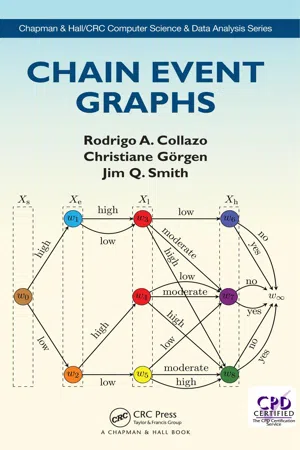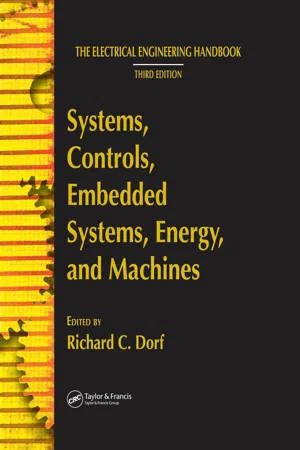Mathematics
Tree Diagram
A tree diagram is a visual tool used to represent possible outcomes and decision paths in a systematic way. It consists of branches that extend from a central node, with each branch representing a different option or outcome. Tree diagrams are commonly used in probability and decision analysis to illustrate and calculate the likelihood of various events occurring.
Written by Perlego with AI-assistance
Related key terms
3 Key excerpts on "Tree Diagram"
- eBook - ePub
- Deborah J. Rumsey(Author)
- 2018(Publication Date)
- For Dummies(Publisher)
Figure 3-8 .Figure 3-8: Tree Diagram created by flipping a coin twice.Two branches, H and T, represent the first coin flip. From each of those branches comes the possible outcomes of the second flip, H and T, which gives you a total of total pathways on the tree, representing each of the four possible outcomes of the sample space. For example, if you follow the top pathway of the Tree Diagram, you get the outcome HH, which in probability notation is . If you follow the bottom pathway on the tree, you get the outcome TT, written as . The second pathway from the top, HT (or ), denotes getting a head first and then a tail; the third pathway from the top, TH (or ), denotes getting a tail first and then a head.Tree Diagrams have a wide variety of uses and can help you solve many different types of problems in probability — in particular, problems that give you marginal and conditional probabilities (see Chapter 2 ). The following sections offer more detail on when Tree Diagrams are ideal.Showing multi-stage outcomes with a Tree Diagram
One of the most common uses for a Tree Diagram is mapping out the sample space. For probability problems involving a large number of stages or a long sequence of events, you need to be able to picture each stage of the process and to identify and count all the possible outcomes in the sample space.Suppose, for example, that you’re taking orders at a pizza restaurant. The process of taking an order goes as follows: - eBook - ePub
- Rodrigo A. Collazo, Christiane Goergen, Jim Q. Smith(Authors)
- 2018(Publication Date)
- CRC Press(Publisher)
They are a lot less commonly thought of as graphical statistical models in their own right, in the way that DAGs are widely used as graphical representations of BNs : see again Section 2.3. But this is precisely how we will treat probability trees throughout this book: as representations of certain statistical models. We briefly repeat the formalism we have developed around probability trees below, referring back to [ 43, 47 ] for further more technical details. We will always denote the product of all primitive probabilities along a root-to-leaf path λ ∈ Λ (T) in a probability tree (T, θ T) by (3.1) p θ, T (λ) = ∏ e ∈ E λ θ (e) where θ = θ T. It can easily be shown that p θ, T defines a strictly positive probability mass function on the set of root-to-leaf paths Λ (T) of the probability tree. We can then think of every λ ∈ Λ (T) representing an atomic event in an underlying probability space, and each of these atomic events will have a positive probability. This assumption is central to our use of models represented by probability trees: we will not depict zero-probability events in an event tree representation of such a model. This enables us to avoid issues related to faithfulness assumptions as present in DAG representations of BN models. In order to be able to provide a few insightful illustrations of probability tree models in the next section, we will again think of distributions p θ, T = (p θ, T (λ) | λ ∈ Λ (T)) over the atoms represented in a probability tree (T, θ T) as vectors or points in Euclidean space: compare the more general Definition 2.1 of discrete statistical models given in Section 2.2. The set of all vectors which respect the assumptions coded in a given probability tree then defines a parametric statistical model (3.2) M (T, θ T) = { p θ, T | θ v ∈ △ ≠ E (v) - 1 o f o r a l l v ∈ V } represented by that tree. We call the set in 3.2 a (probability) tree model and say that the elements in M (T, θ T) factorise according to T - Richard C. Dorf(Author)
- 2017(Publication Date)
- CRC Press(Publisher)
cube sets can be generated as a compact representation of truth tables.Graph-based models. Such as:Boolean network. A graphical model representing a technology independent (before technology mapping) of multilevel circuit structure, or a circuit netlist. A Boolean network is a directed acyclic graph (DAG).Decision trees and decision diagrams. Directed graphs where each node is associated with one classifying test.Boolean formulas allow for the computation of logic functions, while decision trees and diagrams allow for the evaluation of logic functions.Decision Tree
A decision tree is a rooted acyclic graph consisting of a finite vertex set and a set of edges between vertices. Each vertex ν is characterized by in-degree (the number of edges leading to ν ) and out-degree (the number of edges starting in ν ). A graph is rooted if there is exactly one node with an in-degree of 0, the root.A tree is a rooted acyclic graph where each node but the root has an in-degree of 1. This implies that in a tree, for every vertex ν there exists a unique path from the root to ν . The length of this path is called the depth or level of ν . The height of a tree is equal to the largest depth of any node in the tree. A node with no children is a terminal node or leaf . A nonleaf node is called an internal node. The other parameters of a tree are:- The size. The number of nodes
- The depth. The number of levels
- The width. The maximum number of nodes for a level
- The area. Depth × Width
A complete n -level p -tree is a tree withpknodes on level k for k = 0, . . . , n − 1. Apn-leaf complete tree has a level hierarchy (levels 0,1,. . .,n ). The root is associated with level zero and its p
Learn about this page
Index pages curate the most relevant extracts from our library of academic textbooks. They’ve been created using an in-house natural language model (NLM), each adding context and meaning to key research topics.


